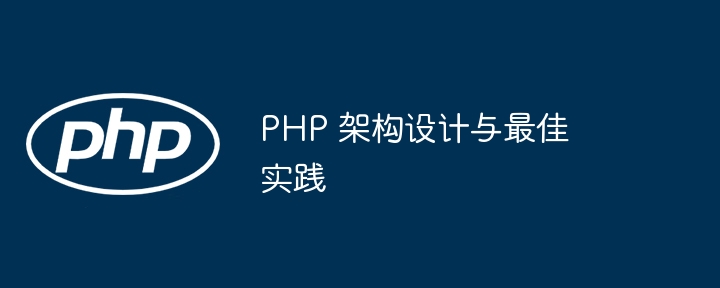Home >Backend Development >PHP Tutorial >PHP architecture design and best practices
PHP architecture design and best practices
- WBOYWBOYWBOYWBOYWBOYWBOYWBOYWBOYWBOYWBOYWBOYWBOYWBOriginal
- 2024-05-07 08:45:011203browse
PHP architecture design and best practices include: MVC architecture: Separate model, view and controller components. Dependency injection: Pass dependencies through containers to improve testability and maintainability. Layered architecture: Divide layers and clarify responsibilities, such as presentation layer, business logic layer and data access layer. Caching: Use a caching tool, such as Redis or Memcached, to store a copy of your data to increase speed. Practical case: An e-commerce website uses a model-view-controller architecture to store product data in the model (Product.php), present it in the view (product.php), and control it through the controller (ProductController.php) , obtain product data through dependency injection.

PHP Architecture Design and Best Practices
Preface
Design and build robust, maintainable PHP Applications are critical to ensure the long-term success of the system. This article focuses on PHP architecture design principles and best practices, and provides practical cases to demonstrate its application.
MVC Architecture
MVC (Model-View-Controller) architecture is a common design pattern that breaks down application logic into three main components:
- Model: Contains application data and business logic.
- View: Responsible for presenting data and interacting with the user.
- Controller: Coordinates the model and view and handles user input.
Dependency Injection
Dependency injection is a pattern for passing dependencies to objects, avoiding hard-coded dependencies. This makes the code easier to test and maintain. In PHP, you can use container to implement dependency injection.
Layered Architecture
Layered architecture divides the application into layers, each with clearly defined responsibilities. Common layers include:
- Presentation layer: Handles user interaction.
- Business logic layer: Contains the main business logic of the application.
- Data access layer: Responsible for interacting with the database.
Caching
Caching is a technology that stores copies of data to increase access speed. In PHP, you can use caching tools such as Redis or Memcached.
Practice case
E-commerce website example
Consider an e-commerce website, we use the following architecture:
// 模型 (entity/models 目录下的 Product.php)
class Product
{
private int $id;
private string $name;
private float $price;
// 获取器和设置器略去
}
// 视图 (templates/product.php)
<h1>{! $product->name !!}</h1>
<p>价格:{! $product->price !!}</p>
// 控制器 (controllers/ProductController.php)
use App\Models\Product;
class ProductController
{
public function index()
{
// 获取产品数据
$product = Product::find(1);
// 将数据传递给视图
return view('product', ['product' => $product]);
}
}Conclusion
Following PHP architectural design and best practice principles is critical to building robust, maintainable applications. MVC architecture, dependency injection, and layered architecture provide a highly structured foundation. Caching technology can improve performance. By implementing these principles, programmers can improve code quality and ensure the long-term success of their applications.
The above is the detailed content of PHP architecture design and best practices. For more information, please follow other related articles on the PHP Chinese website!

